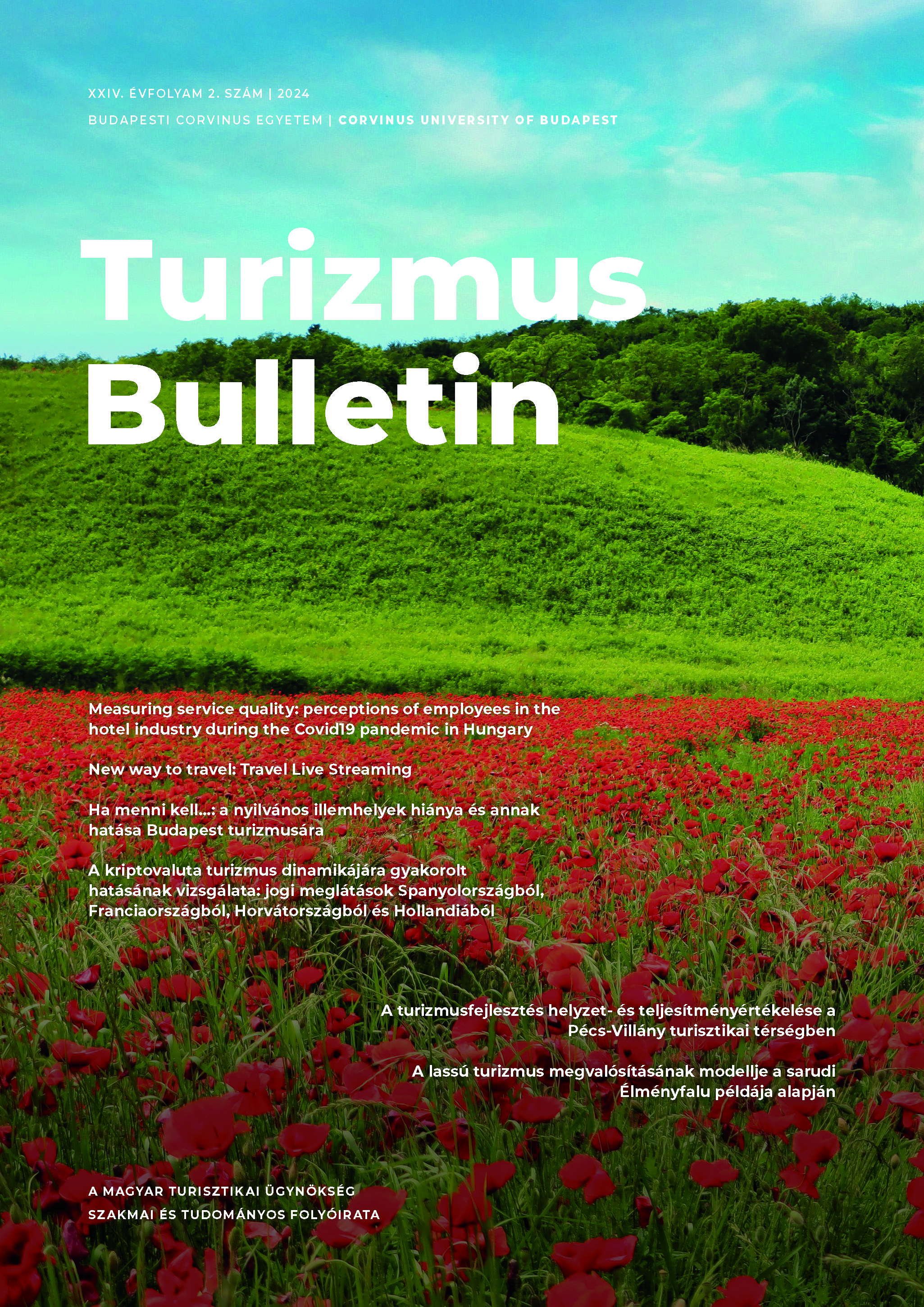A model for implementing slow tourism based on the example of Sarud Experience Village
DOI:
https://doi.org/10.14267/TURBULL.2024v24n2.6Keywords:
slow tourism, rural development, Lake Tisza, Adventure Village of SarudAbstract
The popularity of slow tourism is on the rise in Hungary. Travellers yearn to get back to nature, to the natural environment, where they can experience a traditional way of life and local culture, leaving behind the hustle and bustle of everyday life. Slow tourism also offers the opportunity to immerse oneself in a new way of life and to experience an old-new way of life. Slow tourism represents a sustainable form of tourism which focuses on slowing down the pace of life and exploring local culture, nature, gastronomy and communities. This experience-focused travel approach aims to recharge the body, mind and spirit, while minimising the ecological footprint. Our study shows how the implementation of slow tourism in the Sarud Experience Village is built on local resources and the involvement of local residents, strengthening the identity of the village while providing a quality experience for visitors, tailored to the needs of travellers.
References
BALABAN, E. – CSAPODY B. (2023): A „lassú mozgalom” főbb irányvonalai – Turizmus, étkezés és városirányítás. In: Keller K. (szerk.): A turisztikai niche termékek. Akadémiai Kiadó, Budapest.
BALABAN, E. – KELLER K. (2023): A lassú turizmus szakirodalmi áttekintése. Turizmus Bulletin. 23(2). pp. 47–57. https://doi. org/10.14267/TURBULL.2023v23n2.5
BENJAMIN, S. – DILLETTE, A. – ALDERMAN, D. H. (2020): “We can’t return to normal”: committing to tourism equity in the post pandemic age. Tourism Geographies. 22(3). pp. 476–483. https://doi.org/10.1080/14616688.202 0.1759130
CAFFYN, A. (2015): Advocating and Implementing Slow Tourism. Tourism Recreation Research. 37. pp. 77–80. DOI:10.1080/02508281.2012.11081690
CAFFYN, A. (2012): Advocating and implementing slow tourism. Tourism Recreation Research. 37(1). pp. 1–4. https://doi.org/10.1080/02508281.2012. 11081690
CONWAY, D. – TIMMS, B. F. (2010): Re-branding alternative tourism in the Caribbean: The case for ’slow tourism’. Tourism and Hospitality Research. 10(4). pp. 329–344. DOI: 10.1057/ thr.2010.12
DÁVID L. – TÓTH G. – BUJDOSÓ Z. – HERNECZKY A. (2007): A turizmus és a regionális versenyképesség kapcsolatának mutatói a Mátravidék példáján keresztül. Észak Magyarországi Stratégiai Füzetek. 4(1). pp. 3–20.
DICKINSON, J. – LUMSDON, L. (2010): Slow Travel and Tourism. Routledge. EL ARCHI, Y. – BENBBA, B. – NIZAMATDINOVA, Z. – ISSAKOV Y. – VARGÁNÉ G. I. – DÁVID L. D. (2023): Systematic literature review analysing smart tourism destinations in context of sustainable development: current applications and future directions. Sustainability. 15(6). 5086. doi.org/10.3390/su15065086
GONDA, T. – ANGLER, K. – CSÓKA, L. (2021): The Role of Local Products in Tourism. European Countryside. 13(1). pp. 91–107. https:// doi.org/10.2478/euco-2021-0006
MATOS, R. (2004): Can “ slow tourism” bring new life to Alpine regions? In: K. Weimar, K. – Mathies, C. (eds): The tourism and leisure industry: Shaping the future. pp. 93–104. New York, NY: Routledge.
NAGY, B. – GABOR, M. R. – BACOŞ, I. B. – KABIL, M. – ZHU, K. – DÁVID, L. D. (2023): Google and Apple mobility data as predictors for European tourism during the COVID-19 pandemic: A neural network approach. Equilibrium. Quarterly Journal of Economics and Economic Policy. 18(2). pp. 419–459. https://doi. org/10.24136/eq.2023.013
PARK, E. – KIM, S. (2016): The potential of Citta slow for sustainable tourism development: enhancing local community’s empowerment. Tourism Planning & Development. 13(3). pp. 351–369. https://doi.org/10.1080/21568316.2015.1114015
PÉCSEK B. (2014): Gyorsuló idő, lassuló turizmus: a lassú turizmus modellezése. Turizmus Bulletin. 16(1). pp. 3–10.
PETRINI, C. (2007): Slow Food Nation. New York: Rizzoli Ex Libris.
PISKÓTI I. – MARIEN A. – PAPP A. – NAGY K. (2023): Slow és turizmus – a kisvárosfejlesztési alternatíva!? Marketing & Menedzsment. 57. (Különszám EMOK 2). pp. 55–64. DOI: 10.15170/MM.2023.57.KSZ.02.06
PISKÓTI I. – NAGY K. – MARIEN A. – PAPP A. (2022): Desztinációmarketing – Abaúj Stratégia modellalkotó inspirációi. Turisztikai és Vidékfejlesztési Tanulmányok. 7(1). pp. 35–57. DOI: 10.15170/TVT.2022.07.01.03
PRIATMOKO, S. – KABIL, M. – VASA, L. – PALLÁS, E. I. – DÁVID, L. D. (2021): Reviving an Unpopular Tourism Destination through the Placemaking Approach: Case Study of Ngawen Temple, Indonesia. Sustainability. 13(12). 6704. https://doi.org/10.3390/su13126704
TÓTH N. – KASZÁS N. – KELLER K. (2018): Turizmus a helyi termékek nyomában, avagy egy határon átnyúló tematikus út kialakításának lehetőségei. Marketing & Menedzsment. 52(2). pp. 47–58.
TÓTH, G. – DÁVID, L. D. – VASA, L. (2014a): A közlekedés szerepe az európai turisztikai áramlásokban. Területi Statisztika. 15(2). pp. 160–176. https://doi.org/10.3986/AGS54205
TÓTH, G. – DÁVID, L. D. – VASA, L. (2014b): The role of transport European tourism flows. Acta Geographica Slovenica. 54(2). pp. 311–320. https://ojs.zrc-sazu.si/ags/article/view/1915
VÁRHELYI T. (2019): A Tisza-tó fejlesztésének stratégiai lehetőségei. In: Gyurkó Á. – Somodi Tót O. (szerk.): #Turizmus #szálloda #vendéglátás: jubileumi kiadvány az Eszterházy Károly Egyetem Turizmus Tanszék alapításának 10. évfordulója alkalmából. Eger, Magyarország. Líceum Kiadó. pp. 151–158.
VASVÁRI M. – DÁVID L. – SZABÓ SZ. (2011): A területhasználat néhány változása és következményei a Tisza-tónál. Gazdálkodás. 55(4). pp. 395–406.

